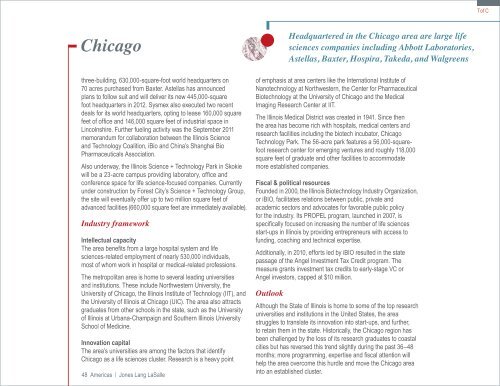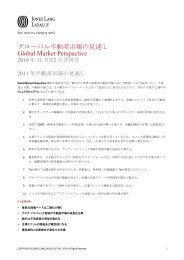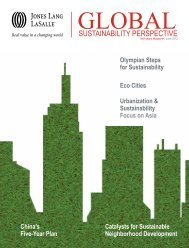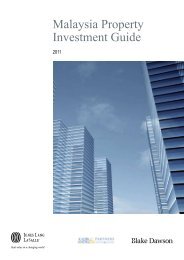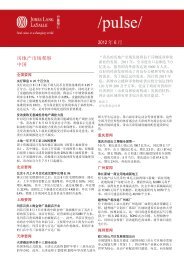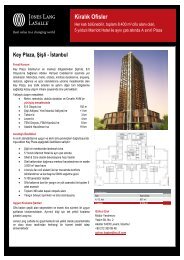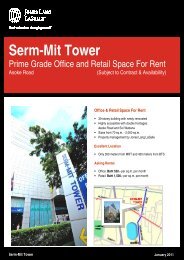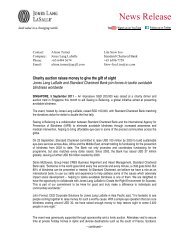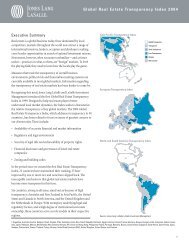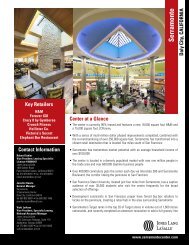Global Life Sciences Cluster Report 2011 - Jones Lang LaSalle
Global Life Sciences Cluster Report 2011 - Jones Lang LaSalle
Global Life Sciences Cluster Report 2011 - Jones Lang LaSalle
Create successful ePaper yourself
Turn your PDF publications into a flip-book with our unique Google optimized e-Paper software.
Chicago<br />
three-building, 630,000-square-foot world headquarters on<br />
70 acres purchased from Baxter. Astellas has announced<br />
plans to follow suit and will deliver its new 445,000-square<br />
foot headquarters in 2012. Sysmex also executed two recent<br />
deals for its world headquarters, opting to lease 160,000 square<br />
feet of office and 146,000 square feet of industrial space in<br />
Lincolnshire. Further fueling activity was the September <strong>2011</strong><br />
memorandum for collaboration between the Illinois Science<br />
and Technology Coalition, iBio and China’s Shanghai Bio<br />
Pharmaceuticals Association.<br />
Also underway, the Illinois Science + Technology Park in Skokie<br />
will be a 23-acre campus providing laboratory, office and<br />
conference space for life science-focused companies. Currently<br />
under construction by Forest City’s Science + Technology Group,<br />
the site will eventually offer up to two million square feet of<br />
advanced facilities (660,000 square feet are immediately available).<br />
Industry framework<br />
Intellectual capacity<br />
The area benefits from a large hospital system and life<br />
sciences-related employment of nearly 530,000 individuals,<br />
most of whom work in hospital or medical-related professions.<br />
The metropolitan area is home to several leading universities<br />
and institutions. These include Northwestern University, the<br />
University of Chicago, the Illinois Institute of Technology (IIT), and<br />
the University of Illinois at Chicago (UIC). The area also attracts<br />
graduates from other schools in the state, such as the University<br />
of Illinois at Urbana-Champaign and Southern Illinois University<br />
School of Medicine.<br />
Innovation capital<br />
The area’s universities are among the factors that identify<br />
Chicago as a life sciences cluster. Research is a heavy point<br />
48 Americas | <strong>Jones</strong> <strong>Lang</strong> <strong>LaSalle</strong><br />
of emphasis at area centers like the International Institute of<br />
Nanotechnology at Northwestern, the Center for Pharmaceutical<br />
Biotechnology at the University of Chicago and the Medical<br />
Imaging Research Center at IIT.<br />
The Illinois Medical District was created in 1941. Since then<br />
the area has become rich with hospitals, medical centers and<br />
research facilities including the biotech incubator, Chicago<br />
Technology Park. The 56-acre park features a 56,000-squarefoot<br />
research center for emerging ventures and roughly 118,000<br />
square feet of graduate and other facilities to accommodate<br />
more established companies.<br />
Fiscal & political resources<br />
Founded in 2000, the Illinois Biotechnology Industry Organization,<br />
or iBIO, facilitates relations between public, private and<br />
academic sectors and advocates for favorable public policy<br />
for the industry. Its PROPEL program, launched in 2007, is<br />
specifically focused on increasing the number of life sciences<br />
start-ups in Illinois by providing entrepreneurs with access to<br />
funding, coaching and technical expertise.<br />
Additionally, in 2010, efforts led by iBIO resulted in the state<br />
passage of the Angel Investment Tax Credit program. The<br />
measure grants investment tax credits to early-stage VC or<br />
Angel investors, capped at $10 million.<br />
Outlook<br />
Headquartered in the Chicago area are large life<br />
sciences companies including Abbott Laboratories,<br />
Astellas, Baxter, Hospira, Takeda, and Walgreens<br />
Although the State of Illinois is home to some of the top research<br />
universities and institutions in the United States, the area<br />
struggles to translate its innovation into start-ups, and further,<br />
to retain them in the state. Historically, the Chicago region has<br />
been challenged by the loss of its research graduates to coastal<br />
cities but has reversed this trend slightly during the past 36–48<br />
months; more programming, expertise and fiscal attention will<br />
help the area overcome this hurdle and move the Chicago area<br />
into an established cluster.<br />
Tof C


